
Why do you need to know how to sharpen ceramic knives? Perhaps you own one or more of these lightweight, rust-free counterparts to metal knives. Maybe you’ve heard that ceramic knives never get dull. Unfortunately, this is a myth. Sure, ceramic blades boast a reputation for staying sharp longer than metal blades do, but nothing (not even a ceramic knife’s razor-like edge) lasts forever.
No doubt about it.
Made from zirconium dioxide (also known as zirconia), ceramic blades measure 8.5 on the Mohs scale of mineral hardness. The hardest mineral–diamond–measures 10 and hardened steel blades measure 7.5 to 8. Under normal use, ceramic knives retain their edge for a long time but still need proper sharpening.
But wait:
Unless you’re already skilled at manually sharpening knives, you might be intimidated by sharpening your ceramic knives. In such case, you can always check to see if your ceramic knife’s manufacturer will sharpen it.


Spencer Lowe is a freelancer writing out of Lewiston, Idaho. He has written articles on banks, politics, and toilets--some of which have gone viral.
Spencer has been collecting toys since childhood. He has a deep connection with the force and is a crack nerf shot.
If you want to avoid the hassle and expense of sending your ceramic knives out for professional sharpening, don’t worry because there are at-home options. Just be sure to check your ceramic knife’s warranty before proceeding with caution.
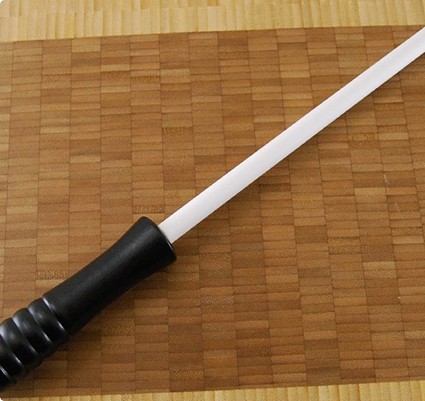
It's easy to be confused by the terms "ceramic rod knife sharpener" or "ceramic knife sharpener rod". You don't want to use these on ceramic knives. Made from and using ceramic as an abrasive, these rods are designed for sharpening metal blades, which are softer. Ceramic rods are not hard enough to sharpen ceramic knife blades.
What does this mean for you?
Instead, look for an electric knife sharpener designed to work on ceramic knives. Some electric knife sharpeners sharpen both metal and ceramic knives; some don’t.
You see:
Diamonds are not just a girl’s best friend–diamonds are one of the industry’s best friends. The hardest naturally occurring mineral, diamond is able to cut through any material, like metal and rock. So look for an electric knife sharpener with diamond abrasives on wheels that grind against the blade during sharpening. After all, ceramic blades are made of zirconia, which is diamond’s less hard jewelry “twin.”
An electric knife sharpener for ceramic knives has diamond abrasives, should be labeled (on the box and in the instructions) to specify that it sharpens ceramic knives, and may be pricier than other electric knife sharpeners. Less expensive models usually lack diamonds, but instead, have ceramic or tungsten carbide abrasives, which are sharp enough for metal but not ceramic.
Bestazy article 9 Cutting Electric Knife Sharpener Reviews — Stay Sharp in 2018 explains how an electric knife sharpener works. An electric knife sharpener has one to four slots for different levels of coarseness (like sandpaper). Each slot represents a stage in the sharpening process. Internal abrasive discs spin and rub against the blade to sharpen its edge. The first slot is for pre-sharpening a dull and/or nicked knife. The second is for more refined sharpening. And the third is for honing and polishing.
Everything You Need To Sharpen Your Ceramic Knives
To sharpen your ceramic knife effectively, you need:
What says class better than a feces pun proudly displayed in your guest bathroom? This lavatory mist features jasmine and red tea, but the real star is the image of Pootin sitting on his horse, with a caption above him saying “I cover your filthy secrets. I bring odor to its knees”.
You’re really not supposed to drink more than a glass of wine, but you feel like you could gulp down the entire bottle? This wine glass was made to help with that exact problem! Big enough to hold a whole bottle, this glass has I Only Have Time for ONE Glass of Wine written on it in huge, block letters.
Make sure no one ever comes near your spare keys! Let’s face it – doormats and flower pots don’t make for the best hiding spots. After all, it’s where everybody keeps them. But hiding them inside fake, but realistic dog poop will surely do the trick of repelling potential thieves.
If your cat could talk, you’d definitely get into trouble for buying this. But she can’t, so you can go about your business, trying to make your loved ones think she can. This gift box is empty, but it features images of the animal translator collar that’s allegedly inside.
If regular journal keeping just isn’t something you can see yourself doing, Keri Smith has the right task for you. In Wreck This Journal, she invites you to poke holes through pages, deface scrapbook photos, and the like. If you’re wondering what exactly you’d end up with, you know what to do.
Be the author of the next book you’ll read. If that sounds interesting, get your hands on Finish This Book, the work of bestselling author Keri Smith and, of course, yourself. You’ll start by undergoing secret intelligence training, but nobody really knows where your journey will take you.
There’s no way to track time that’s quite as mesmerizingly beautiful as with this unique hourglass. Placed on an elegant wooden base, it uses a hidden magnet to pull down ferrous sand. While falling, the sand creates lovely stalagmites you can admire for a lot longer than the one-minute countdown.
Take your gaming sessions to a whole other level by using a great-looking, high-performance keyboard. Its top-quality injection molded keycaps make it perfect for gamers, programmers and writers alike. LED effects with three different brightness settings add a touch of cool to your devices.
Learn how to take truly stunning photos without having to memorize any technical terms. This book contains only information that’s useful to you when you’re ready to snap that perfect shot. Not to mention that it’s packed with gorgeous examples of professional photography.
If clothes make the man, do they make pets, too? If so, you’re in for a real treat! This cat outfit includes a sheriff onesie and a hat with a badge. They’re easy to put on, so you don’t have to worry about your pet getting mad at you. And then they can go exercise their right to boss everyone around.
Let Pikachu follow you wherever you go, just like he did with Ash! This eye-catching hat features the face of the adorable Pikachu, with his ears sticking out to make an even bigger impression. Since it has a snap closure, it can fit kids of all ages and, yes, adults, too.
Now you can finally realize your lifelong dream of becoming the ultimate bird watcher slash opera goer slash intelligence agent! You only need to have these mini binoculars on hand wherever you go. Since you won’t damage them by getting them wet, nothing’s out of bounds!
Give the universe a lick with this unique mix of lollipops. The back of each is black, resembling the outer space, while the front is clear, adding depth to the image. They come in a range of flavors, so there’s something for everyone. Serve these at your next space party or devour the cosmos yourself!
Give your friends and family a proper scare when they least expect it! With the help of this mix of decals, you can turn your toilet into a place from which emerge yucky octopus tentacles and even decomposing zombie hands. Simply stick them onto the seat and cover, and wait to hear the first screams!
Make sure your next camping trip doesn’t get interrupted by any sudden deaths. Bringing the world’s toughest tent should be more than enough. Made from thick, tear-resistant materials and easily packable into the tiniest bag, it’s the ideal companion for two people embarking on a dangerous trip.
Turn your backyard into a real amusement park with this incredible water slide! Twenty five feet long and equipped with sprinklers, it’s perfectly capable of entertaining your entire family. Since it’s made of embossed PVC, you don’t even need to add soap to achieve smooth rides.
Drinking only one cup of coffee a day has finally been made possible! Big enough to hold 64 ounces of liquid, this mug is the ideal gift for that one friend who can’t seem to stop drinking coffee, but if they don’t like it, you can also use it as a container for, well, 64 ounces of stuff.
What better way to cool off than by having a unicorn spray you with water from his magic horn? This huge inflatable toy unicorn doubles as a sprinkler for hot summers. Compatible with most garden hoses, it makes playing in the yard super fun for the entire family. Or just yourself – no one’s judging.
If there ever were a marathon in writing stuff by hand, you’d be the first one to cross your t’s and dot your i’s. Designed to minimize the strain on your fingers and hand, this pen fits snugly, yet comfortably around your index finger. As a result, you need to put in less effort to actually do the writing.
Had enough of classic LEGO building kits? Okay, it sounds completely absurd now that we say it, but you might still have a lot of fun building a ship in a bottle using only LEGOs. The kit includes everything from the bottle and wax seal elements to the ship with all its parts. Anchors aweigh!
You might be wondering…
Why do I need an electric knife sharpener to sharpen ceramic knives? Sharpening ceramic knives by hand can be very tricky unless you are already experienced and skilled in sharpening any knives (metal or ceramic) manually.
Plus, you’ll need special tools as we noted earlier. Not all knife sharpeners can handle ceramic blades. Use the wrong one and you could end up chipping your blade. And you don’t want to ruin them!
Guess what?
There is a manual knife sharpener that works on ceramic knives: the Fubosi Knife Sharpener – Professional Kitchen Knife Sharpener. With an ergonomic ABS plastic handle and a non-slip base, this effective tool can be used whether you’re left-handed or right-handed. First, read the manufacturer’s directions to familiarize yourself with the recommended process.
Then…
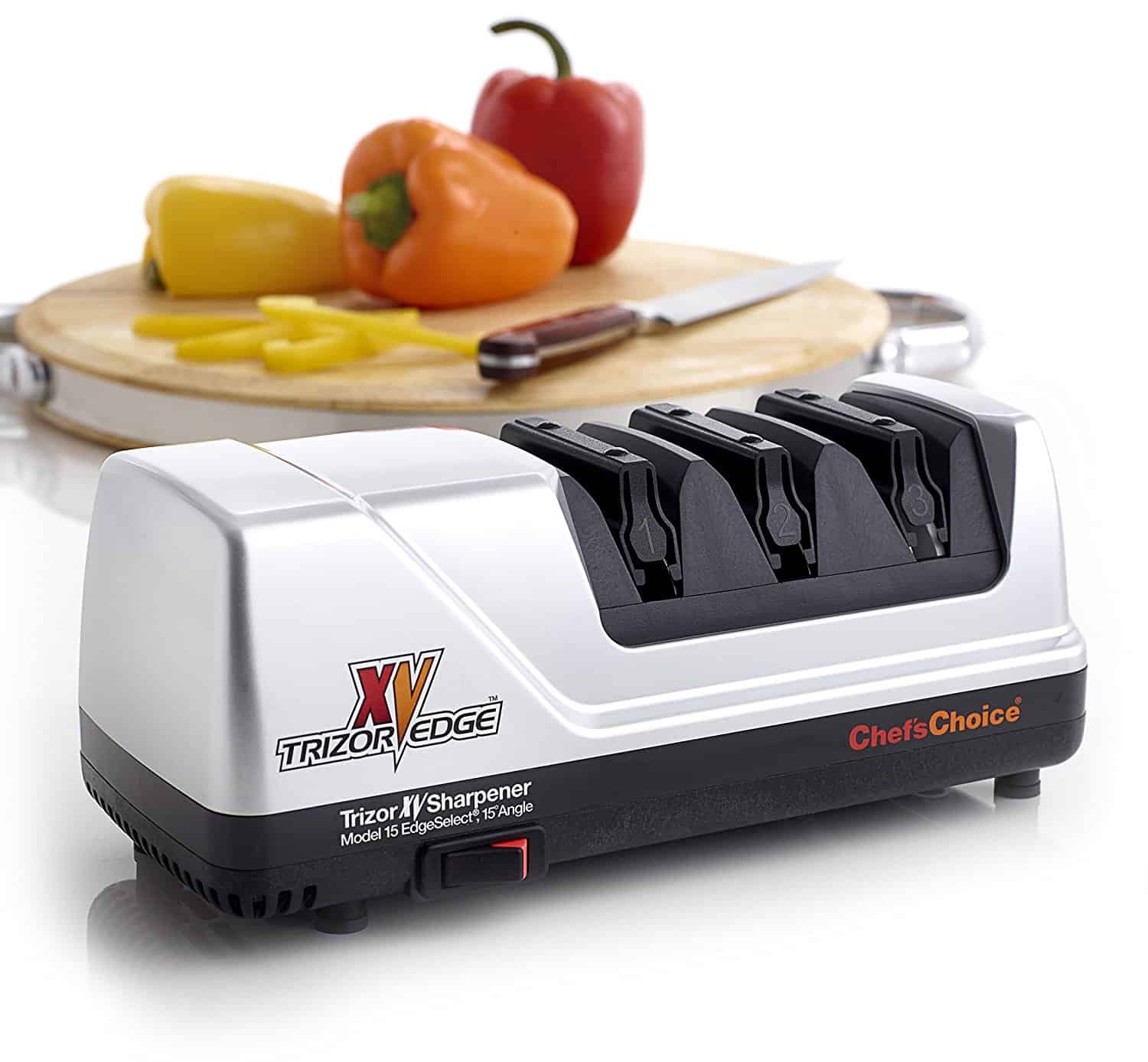
Fubosi Knife Sharpener – Professional Kitchen Knife Sharpener’s three-stage design includes a coarse stage for dull or damaged knives, a fine stage for eliminating burrs or polishing edges, and a ceramic stage for ceramic knives. After using this sharpener, you can clean it by taking out the detachable sharpener head and flushing it with water.
If you’re apprehensive about risking your ceramic knives by manually sharpening them. The best solution is to use an electric model. Luckily, four models from our Electric Knife Sharpener Reviews are designed to work on ceramic knives as well as metal knives. All fitted with diamond abrasives, they are:

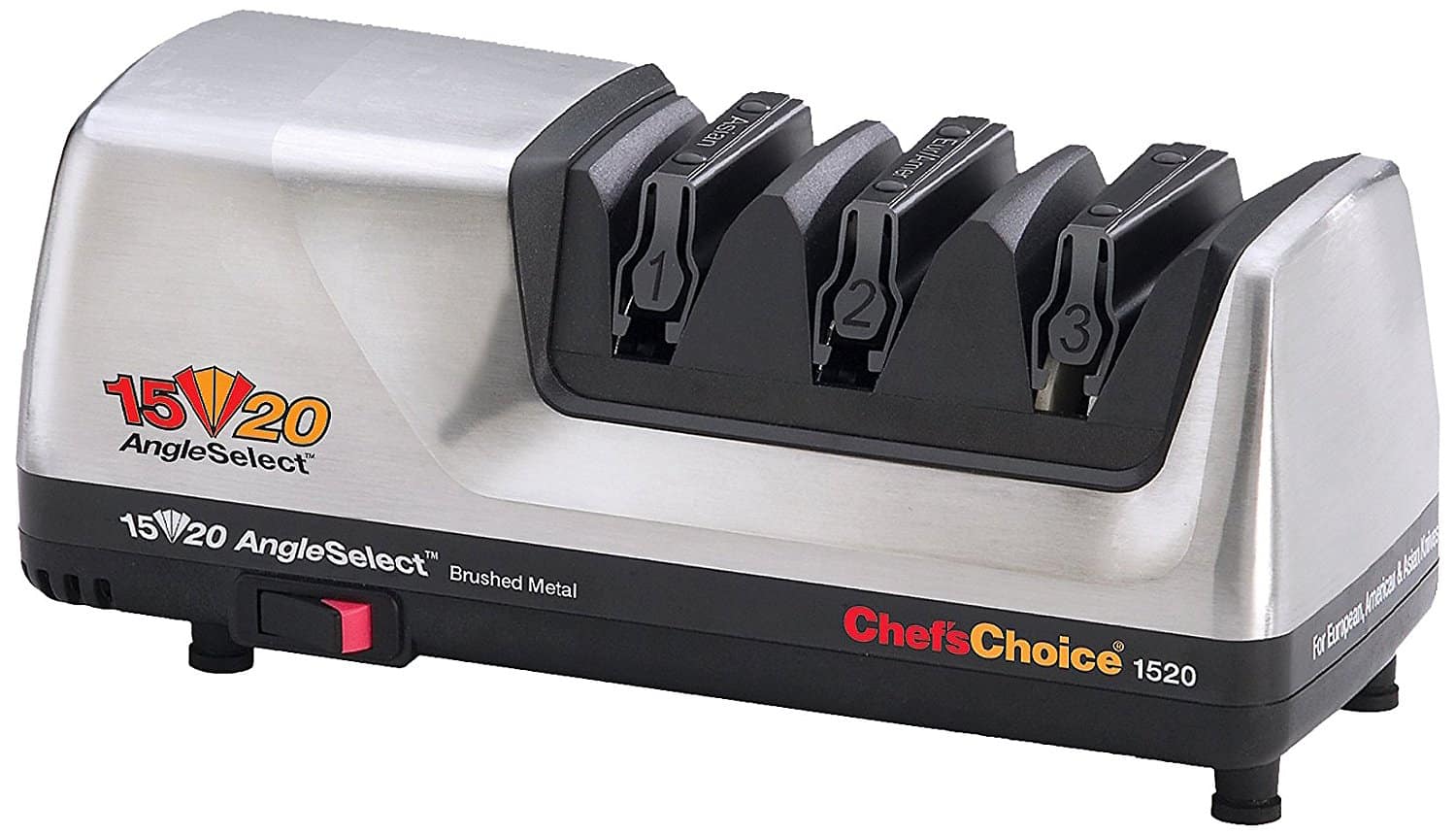
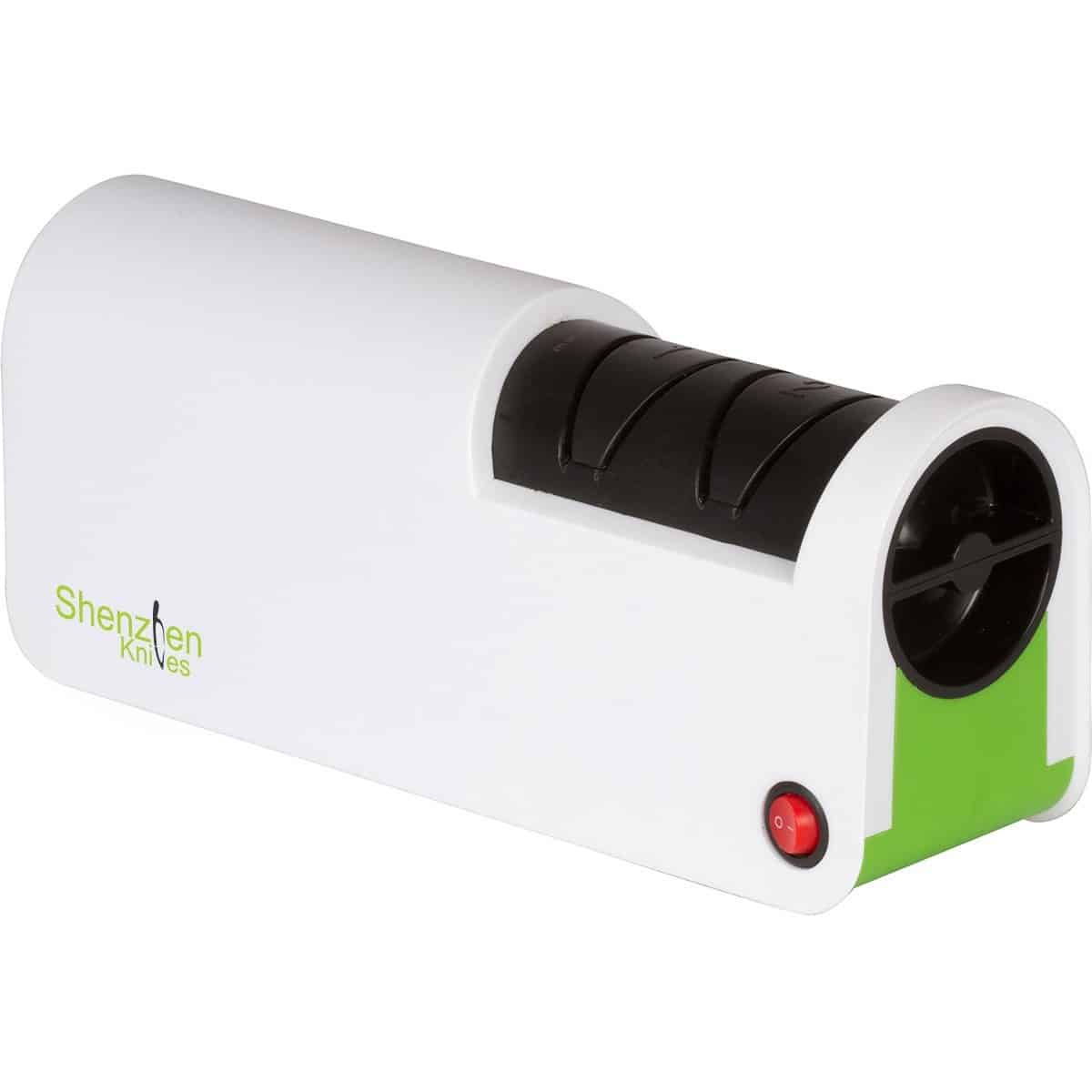
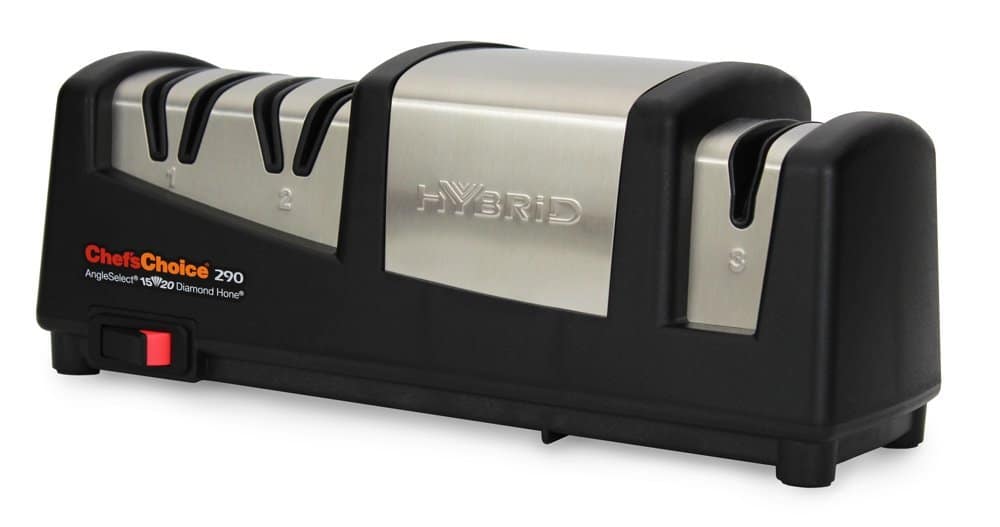
But wait, there’s more…
The Work Sharp Ken Onion Edition Knife & Tool Sharpener, the top-rated model, can be fitted with a diamond abrasive belt to sharpen ceramic knives. No need to purchase a separate sharpener just for ceramic knives; just look for the Work Sharp Diamond Belt Accessory Kit.
Don’t use these diamond belts with metal blades. The belts won’t hurt your knives, but metal blades will clog the belts and make them useless. Each Work Sharp Diamond Belt Accessory Kit includes one coarse diamond belt (180 grit) for repairing ceramic knives and one fine diamond belt (1500 grit) for honing and sharpening ceramic knives.
Although often more expensive than metal knives, ceramic knives may be worth the price because they are:
On the other hand,
Ceramic blades are very brittle, not malleable like metal knives. They easily chip and, when dropped, can shatter. Therefore, ceramic knives need to be handled carefully in the kitchen, according to professors who teach knife skills at Utah State University Cooperative Extension.
Ceramic knives should not be used for cutting bones, cracking nuts, or smashing (e.g., garlic and herbs with the side of the blade) against hard surfaces.
What does this mean?
Although ceramic knives slice smoothly and easily (“like butter!”), they aren’t very versatile in the kitchen. Ceramic knives should not be used on frozen or hard foods. Stick with soft foods (like boneless meats and some fruits and vegetables). If you are looking for an all-purpose knife, you won’t want a ceramic model.
So now that you know about ceramic knives’ quirks, here are some tips for making sure they last a long time:
The day finally arrives when your ceramic knife has finally outlived its usefulness–but what should you do? Unlike metal blades, ceramic blades are not recyclable. So you should wrap the knife in thick material (e.g., cardboard, newspaper, bubble wrap) and seal it in a box before tossing. In our research, we have found that some people make their own “sharps” container with thick plastic tub, like an empty Coffee-mate creamer container, to dispose of old knives.
Now that you know how to sharpen ceramic knives, you are ready for one or an entire set. Ceramic knives come in all different sizes, shapes, and even colors! Browse here for some utilitarian and good-looking ceramic knife sets to brighten up your kitchen and make cooking fun.
Perhaps months or years. Of course, this depends on how much you use your ceramic knife. You can definitely go longer than if you were using a metal knife for the same purposes.
Because you have to push down with force when cutting bread and cheese, we do not recommend using a ceramic knife. You don’t want to snap the blade.




Let us know your opinion